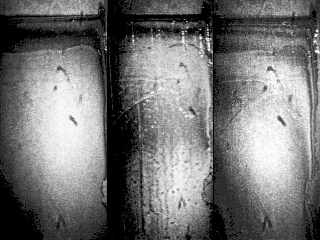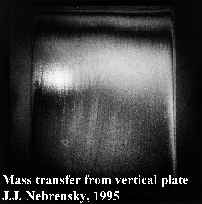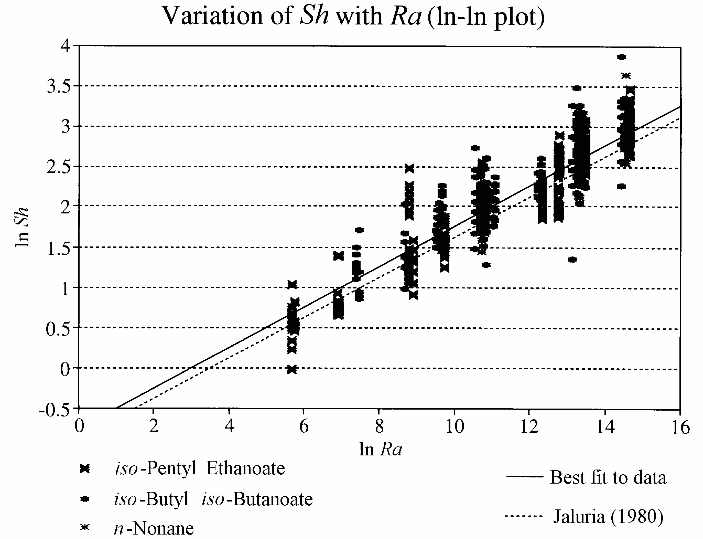
This is part of an old introduction to my PhD project, illustrating how holography and holographic interferometry may be applied to convective mass transfer measurement.
The Newport thermoplastic holographic camera has been used with the swollen polymer method to measure mass transfer in a variety of situations. The work has shown that it is possible both to generate naturally convecting flows using a swollen polymer system, using alkanes and aliphatic esters as swelling agents, and to thus measure local mass transfer coefficients using holography or ESPI.
Initially the results were rather poor and holograms were limited to
a small region of the test plate. This image shows frozen fringes
corresponding to 10, 20 and 50 seconds of flow:

The optical system has since been improved, so that it is now
possible to study the whole of a usefully sized object. The extent of
the increased mass transfer at the plate edges due to entrainment can
clearly be seen:

The ability to use a range of swelling agents allows the technique to
be used to make measurements over a range of Grashof (Gr) and
Schmidt (Sc) numbers:

Here are some simulations of real-time interferometric fringe patterns for swollen polymer experiments in different geometries.
In order to extend the holographic technique to cylindrical rods and other curved surfaces it is necessary to be able to predict and analyse the shape of the fringes. Unlike on flat plates, the fringes seen on curved surfaces are not contours of equal mass-transfer coefficient.
The following are not available from this server.
Some animated simulations of the fringe patterns due to jets impinging on flat plates, using Ethyl Salicylate as a swelling agent (Sc about 2.7).
Laminar jet (Re=1000) impinging on flat plate. z/d=2.5, jet diameter is 0.07 of the frame width, and each frame represents 1.75 seconds. The calculation is based on a series of empirical correlations by Gholizadeh (you can see the joins).(1.4M)
Laminar jet as above, but calculations based on the analysis of Scholtz and Trass (1963) including Glauert's length term. They appear to predict an annular maximum around the stagnation point.(790K)
Laminar jet as above, but calculations based on the analysis of Scholtz and Trass without the Glauert term. The mess in the centre is due to the fringes being less than pixel size.(1.1M)
Laminar jet as above, but now the mass transfer coefficient is calculated from an empirical correlation for heat transfer in liquids given by Webb and Ma (1996). This is a bit dubious as it uses an isoflux, rather than isothermal surface.(1.5M)
The empirical correlations agree fairly well, especially towards the centre of the field where the two theoretical predictions differ widely. That the massive over-prediction of the transport coefficient with the length term ignored is over-corrected by its inclusion suggests that the method of estimating the Glauert length parameter given by Scholtz and Trass (1963) is invalid for the Reynolds and Schmidt numbers used here.
Back to my home page.
Henry Nebrensky
J. Nebrensky @ brunel.ac.uk